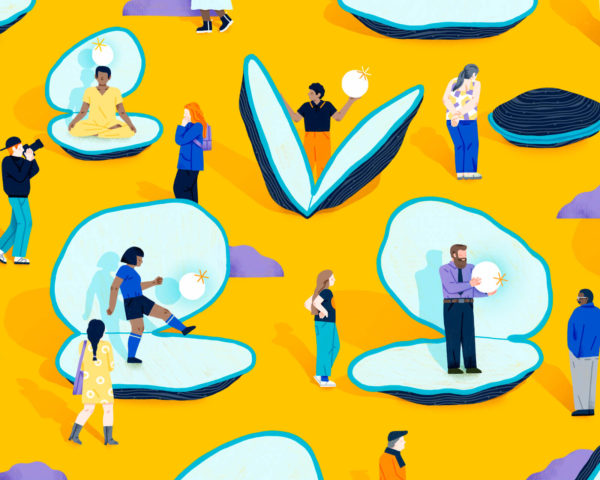Practicing mindfulness at work has benefits beyond your own well-being (although that’s important, too). It helps you be a more effective collaborator. The secret to successful collaboration is the ability to be in three places at once: immersed in the content of the conversation, floating above yourself observing what you’re bringing to the room, and across the overall group dynamics.
Or put another way, you have to be mindful of content, self, and the group all at the same time.
One hypothesis I have about the future of innovation is that less and less of it will be accomplished by individuals or small teams. That’s not to say that small teams aren’t ever going to deliver disruptive innovation. Just that it won’t account for most of the innovations we see.
Increasingly, innovation will require multiple teams of highly skilled, specialized people seamlessly working together no matter your job function or industry. Assuming this is true, facilitating collaboration becomes one of the most important skills you can have as a leader or member of an innovative team.
The three “places” we occupy at work
For better or worse, meetings are where the most visceral collaboration happens. They’re also fraught with peril from a mindfulness perspective. It’s all too easy to daydream or check your email instead of being fully present. So let’s look at the three places in the context of meetings specifically.
The content of the conversation is the decision we are making, the results we are seeking, the prioritization we are doing, the roadmap we are building, the new performance system we are hearing about, the pros and cons we are balancing, the go/no-go calls… the “what.”
The self is the energy you are bringing to the conversation. Are you respecting others’ opinions? Are you sure you are right? Are you frustrated or angry? Do you look upset even if you aren’t? Are you cutting people off? Or checked out because people are talking over each other? Are you avoiding saying something because you don’t want to disagree with the boss?
In short, what is your mental state right now? And how are you making it easier or harder for the group to innovate?
The third place in which to stay mindful is in the dynamics of the group. Notice who’s talking and who isn’t. Who seems to be angry. Who is passionately discussing the content. Who looks tired. What side conversations are happening (or side text conversations, ugh). Who is on their laptop or phone paying no attention.
Notice the tenor of the group. Does it feel like a team? Do people seem like they feel safe to share their thoughts and ideas? Is there energy and excitement?
Groups are an entity in and of themselves. The relationships in the room are complex and varied. The people in the room each bring in different things on different days. Maybe someone just had a fight with their spouse. Maybe two of the people in the room just had a tense 1:1 meeting. Maybe someone has only been with the team for a short time and doesn’t know what to expect.
An effective meeting has healthy conflict and debate, and strong engagement from most of the people in the room. It keeps you on the edge of your seat, wondering what will happen next. If this isn’t happening… something’s wrong.
Remembering to be present
One of my favorite meditation teachers is fond of saying every now again “are you remembering that you are sitting?” or “are you remembering that you are hearing?” or “are you remembering that you are walking?”.
He boils down presence to simply… remembering.
What??
When your mind drifts off to plan or obsess or dream or problem solve, you forget that you are doing any of those things (sitting, walking, hearing, seeing, driving…) at the same time. You lose awareness of the current moment.
In a meeting, most of us have a preference for where we “go” out of the three places I discussed above. Where we get lost and lose presence. I most often go to content, completely focused on the outcomes we are discussing, forgetting to notice how people are responding to me and the general tenor of the group.
Some people go to the self. Usually to defend their status as opposed to the self-awareness and personal accountability I discussed above. But it’s still self. David Rock writes about this extensively in Your Brain at Work.
I get lost in self when I feel disrespected, like my opinion doesn’t matter. A big part of emotional intelligence is noticing when you are getting stuck in self. And instead of getting lost there, being aware of your emotions and energy and regulating them. That’s what we are aiming for.
Some people get lost in the group. Usually because they are uncomfortable with conflict and want to diffuse it instead of looking to establish a culture of innovation. But it’s still group. This is the place I need to work hardest to notice.
The key – the catch – (the whole freaking ballgame really) is being able to move between all three with the perspective of an observer instead of being sucked in. From the perspective of remembering instead of forgetting.
Tips for practicing mindfulness at work
OK, so how to remember? Some techniques that work for me:
- Meditate for a couple of minutes before a meeting. Focus on the intention to remember and be in all three.
- Experiment with using triggers to pull you out of your default. Maybe there is someone you think might derail the meeting. When that person speaks, use that as a trigger to go to all three.
- Use the buddy system. Ask someone you trust to give you a signal occasionally if they see you getting stuck in your default.
- Set a timer to go off on your watch every 15 minutes. It can say “breathe” or “remember” or “am I present right now?” or (my favorite) “stay open”.
And when you remember, take a quick scan of all three.
The other thing that helps me is a regular meditation practice. I am on again/off again, I admit. It’s tough to find the time. But I find that the more regular I am, the more able I am to remember to move between the three places. And of course there are a bunch of other fabulous benefits of meditation written about in countless internet articles 😂.
If mindfulness is the secret… now what?
You may have noticed that mindfulness on its own won’t generate more collaboration. Rather, it’s the base upon which you build. By being in all three places, you can…
- Notice the moment when conflict is starting and move it in the direction of collaboration.
- Notice the moment when a key decision is being made in a less than optimal way.
- Model how treating ideas as impersonal will lead to the most innovative outcomes.
Without mindfulness, everything you read about the softer side of innovation and collaboration will be just theory. Intellectual knowledge that you struggle to implement.
Even when you do practice mindfulness at the office, decisions, conflict management, and egoless innovation still aren’t easy – I’m not gonna lie. They all require vulnerability, and to be vulnerable at work is hard as hell. But by tapping into your sense of purpose, you just might find that you care deeply enough about the work to give it a shot.












































